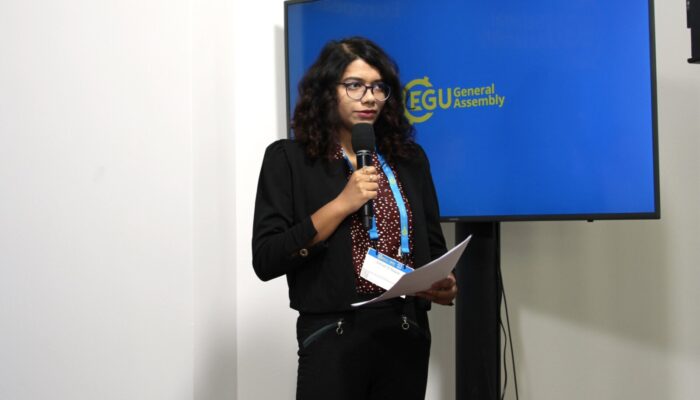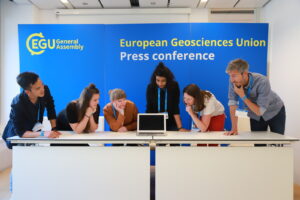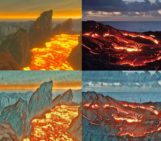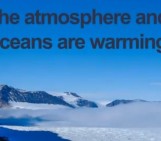
Gillian D’Souza is the European Geosciences Union’s outgoing Media Relations Manager. During her time at EGU Gillian deftly handled the Union’s media interaction and made strides in developing how the Union works with journalists. With Gillian now leaving EGU, we asked her to reflect on her time working for the Union at the science-media interface.
Hello Gillian. During your time at EGU you managed the Union’s science-media relations and output, including having editorial oversight over blog series such as this one. Welcome to the other side of the interview! To begin: what made you pursue a career in science media and communication?
Thanks Simon. I admit it’s quite refreshing to be on the ‘other side’ of the interview for a change! I think it’s fair to say that I entered the field of science communication rather unexpectedly. My career began as a microbiologist, but I soon discovered that my passion for communicating science trumped the joy of being a scientist in a lab.
I find it so fulfilling to witness those special “light bulb” moments when someone from a non-science background can grasp and engage with complex scientific content that I have helped distil and translate for them.
Over the last 10 years, I’ve been lucky to have worked with global non-profits such as the World Health Organization and UNICEF, international pharmaceutical companies, health information websites, and of course scientific institutions like the EGU. In these roles, I’ve dabbled in internal, external and crisis communication, translating science for patients, caregivers, investors, journalists, students, and the broader public.
What motivated you to join EGU?
I’ve always wanted to work directly on the science-media interface, to encourage scientists to share their research with those outside their immediate field of interest. With EGU’s large network of nearly 20,000 scientists, it was an exciting opportunity for me to work with this group, and to grow my own media network across the European continent. Also, with 22 Divisions that span the breath of environmental sciences, I knew that each working day would be different from the other, with countless opportunities to network and be creative.
Can you give our readers an insight into how EGU engages with the science-media interface?
Every day EGU publishes research across 19 peer-reviewed open access journals that cover the Earth, planetary and space sciences. What this means is that we have fascinating insights that impact people around the world, which in my opinion should not be limited to the scientific community.
Our science-media efforts aim to reduce this gap between researchers and the broader public by sharing our research through press conferences, interviews, webinars, press releases, blogs and social media. EGU also supports science journalists through our annual Science Journalism Fellowship, which I think is a fantastic way to encourage geoscience reporting of research that’s not yet made it to the public sphere.
In your time here you developed how the Union interacts with science journalism. What was your focus here?
When I first joined the EGU, I sensed we were rather media-shy, in that we selectively interacted with geoscience-focused journalists and mostly featured senior scientists in media interviews. But given EGU’s vast repository of research, I felt this called for an increase in our science-media engagement, and perhaps even reaching out to non-geoscience media.
In the last couple of years I connected with journalists across the sciences and beyond, and in doing so, managed to have our research promoted in several “general” publications including Vogue, Forbes, BBC, ABC news, Nature World News, International Business Times, Science News, Science Daily, Scientific American, and Carbon Brief.
My aim was really to take the EGU name to people outside of the geosciences, with the hope that our latest research could be a topic of conversation over family breakfast!
When it came to working with early career scientists – many of whom had never spoken to the media before – my own science background certainly helped in that regard. Early career scientists trusted my instincts and welcomed my ideas for them to share their science more widely. At the same time, the journalists I worked with revealed certain gaps in their communication with the scientific community – something that I’ve been actively trying to address through my role at EGU. Our new #ShareYourScience project will soon introduce a number of useful resources and toolkits for journalists and scientists to more effectively communicate with one another, so stay tuned for that in the next few months.
As you leave on your new adventure, looking back, what’s one thing that you wish more people knew about EGU?
That the European Geosciences Union (EGU) is so much more than a community of geoscience experts. We invest significant time and resources towards interactive open-access publishing, facilitate science outreach to students, media and the non-scientific public, drive science-for-policy that influences global decision-making, support geoscience education and training for teachers, and of course, empower early career scientists to engage with the larger community.
And I’d be remiss if I didn’t mention our annual General Assembly, which is Europe’s largest geoscience conference that brings together over 16,000 scientists from around the world. The meeting has so many exciting sessions such as Great Debates and Union Symposia, inter-and transdisciplinary sessions, medal lectures, short courses, and education and outreach sessions, so there’s pretty much something in there for everyone. It’s been quite a journey to work with such a diverse and enthusiastic group of people who, in one way or the other, end up calling EGU their home.



